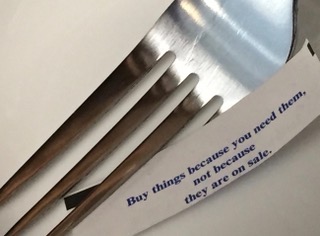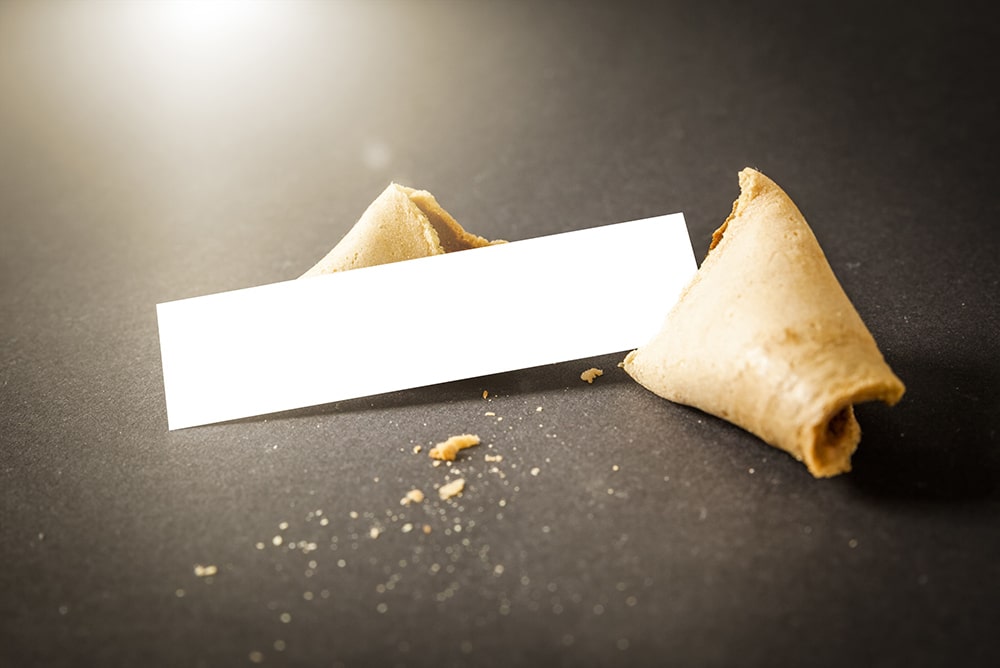The message came in a fortune cookie. In tiny capitals it shouted,
“BUY THINGS BECAUSE YOU NEED THEM, NOT BECAUSE THEY ARE ON SALE.”
 Now, the first directive of the not-so-cryptic cookie says, “buy things because you need them.” Indeed, “need” is a big 4-letter word. You can nose around in needs, but that’s unsatisfying. Wants and desires are the real oxygen.
Now, the first directive of the not-so-cryptic cookie says, “buy things because you need them.” Indeed, “need” is a big 4-letter word. You can nose around in needs, but that’s unsatisfying. Wants and desires are the real oxygen.
Thank goodness for things we don’t need! The minimalist doctrine has good points, but if we were all minimalists, who would be munching up all that commerce, all our products, all our services? “Need” for this discussion, I propose, is “wants, needs, and desires.”
And if we agree on that expanded definition, let’s rebake the decree:
“Buy things because you want, need, or desire them, not because they are on sale.”
Take out the “sale” imperative, and you have really just flattened out Maslow’s Hierarchy of Needs. And as a student of Roy H. Williams, you may recall Roy’s excellent exposition on its relationship to messaging.
Back to contemplating the cookie…What if your customers only bought things they wanted, needed, or desired as a matter of some other factor not price? It seems that a good many of them probably do.
Countless articles and studies cite many of the factors which enter into customers’ purchase decisions. Katlin Smith in Inc. magazine notes these: Identity, Value, Experience, Connectivity, and Need.
Building a brand is important. Consumers who are loyal to a brand are willing to spend more with the brand. A holiday focused study recently cited in Chain Store Age, brought out the strength of brands in regards to holiday gifting. 41% of the 4,000 respondents surveyed were more likely to buy a holiday gift from a brand they loved. Another 17% said price was important but brand matters more.
And for a deep reach into the internet cookie jar (pun intended), start with Tim Smith’s article, “Price is Not (Always) the Most Important Driver to Customer Purchasing Behavior.” Besides naming a number of other factors important in purchase decisions, Smith explores boundary pricing. Finding where prices aren’t too high and too low. He concludes,
“Make the phase transition to pricing within your boundary guiderails, preferably on the upper end of those guiderails. As long as you are in the guiderails, you may be able to remove price as a driver to customer purchase decisions.”
The next time you think the only thing you need to adjust is your price, think again. Maybe your price is outside the guardrails, but if it isn’t, what then? You will need to ask the question about what is driving the consumer’s decision not to buy. That’s a tougher question to ask and the answers are harder to swallow. Acting on the answers is harder still…but isn’t that how fortunes are made?
- Derby Cars and Critics Both Race to the Bottom. But Your Leadership Must Not. - October 5, 2023
- Are you overlooking something that’s holding you back? How my “aha!” moment could help. - September 14, 2023
- What Spartan Women Can Teach Us About Advertising - October 12, 2022

